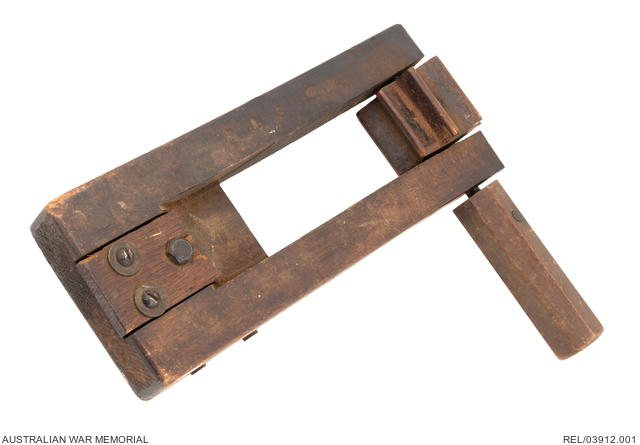| Accession Number | REL/03912.001 |
|---|---|
| Collection type | Heraldry |
| Object type | Personal Equipment |
| Physical description | Metal, Plywood, Wood |
| Maker |
Unknown |
| Place made | United Kingdom: England, Greater London, London |
| Date made | c 1915-1918 |
| Conflict |
First World War, 1914-1918 |
| Source credit to | This item has been digitised with funding provided by Commonwealth Government. |
Gas rattle : British Army




Rectangular hardwood box structure fitted with a rotating hexagonally shaped handle. A single nail has been hammered through the handle. This handle is secured to the opposite end via a metal axle. Above the handle the hardwood frame has been cut at an angle. Attached to this is a rectangular shaped piece of metal with four screws. An eight sided wooden cog ratchet is attached to the metal axle. This ratchet would normally touch upon a wooden tongue which no longer exists. The partial remains of the plywood tongue are secured internally by three screw bolts and two metal washers. A hardwood bar located immediately behind the end of the tongue is fitted to prevent excessive movement of the tongue. An eliptically shaped line follows this bar along the inside of both internal sides. The hardwood bar is secured to the box structure by a pair of dowel which have been hammered through the structure. The manufacturers stamping 'S A S' has been stamped into the rattle in several places including both external sides, on the end surface, underneath the rattle and on the base of the handle. On one external face is also stamped a Government Broad Arrow underneath which is the number 49 and the letter 'G'.
During the First World War poisonous gases such as chlorine, phosgene and mustard gas were released silently from cylinders, or quietly discharged from exploding gas artillery shells. The loud and distinctively sharp clacking noise made by gas rattles stood out amongst the other sounds heard in the trenches and nearby soldiers would rush to put on their protective gas equipment, such as respirators and hoods.
After the First World War tens of thousands of these rattles (and civilian made copies) entered the civilian market with many of them being associated with English football (soccer) matches until the 1970's. Similar rattles to this were also used in Australia during the Second World War by civil defence organisations in the event of the use of gas by the Imperial Japanese on the civilian population.
This example is from the First World War and was likely made in the United Kingdom during the war after the introduction of gas warfare by the Germans on the Western Front in 1915. The manufacturers markings 'S A S' are stamped in five seperate locations along with a distinctive Government Broad Arrow and the numbers 49 over the letter 'G'. One variation on this particular gas rattle is the rectangular shaped piece of metal screwed onto the rattle above the handle. It appears to have been used to secure the metal axle which rotates the handle.